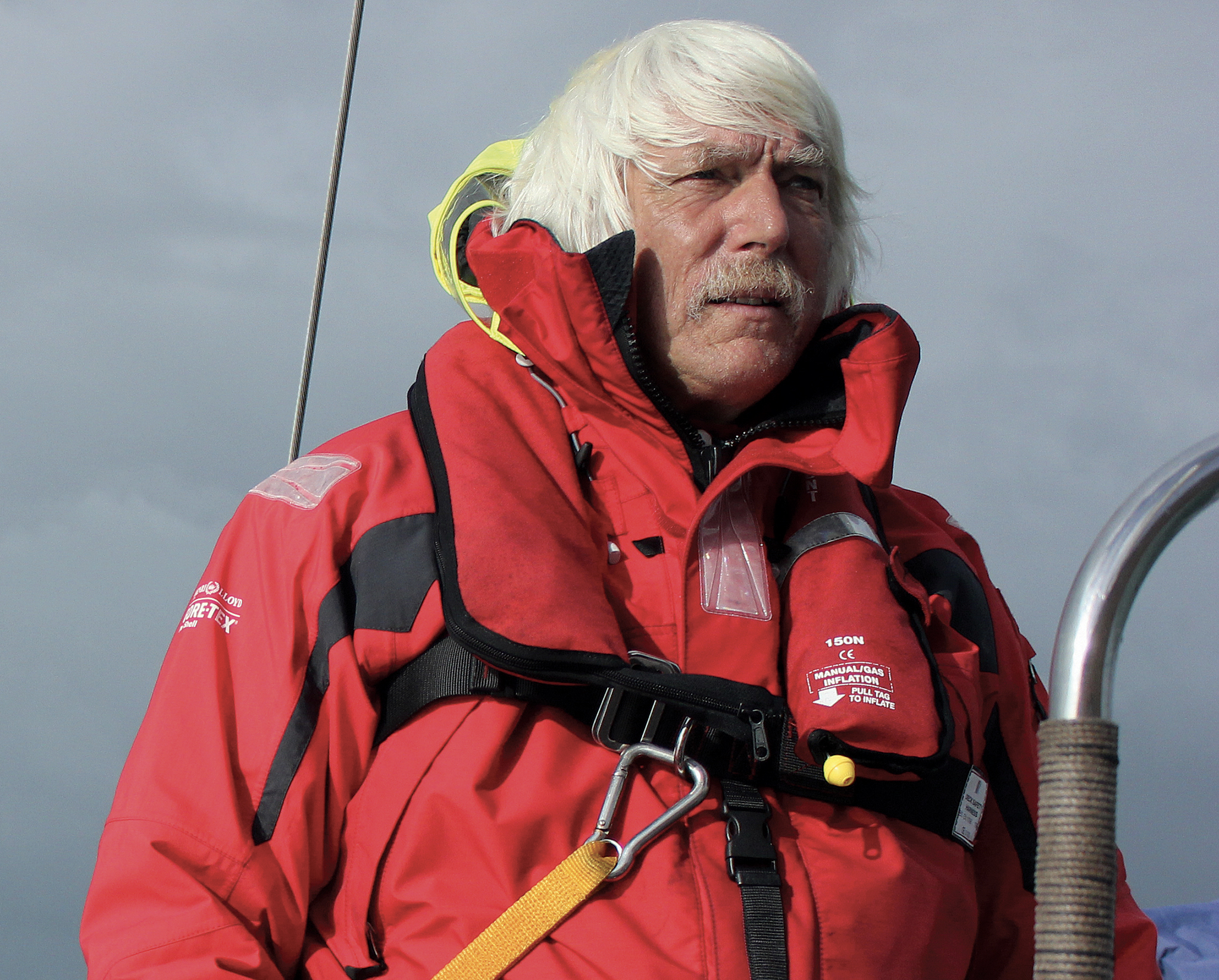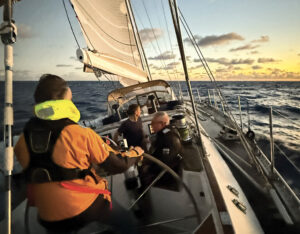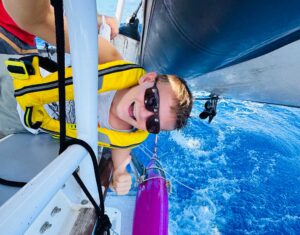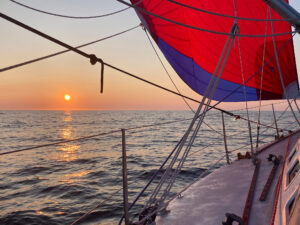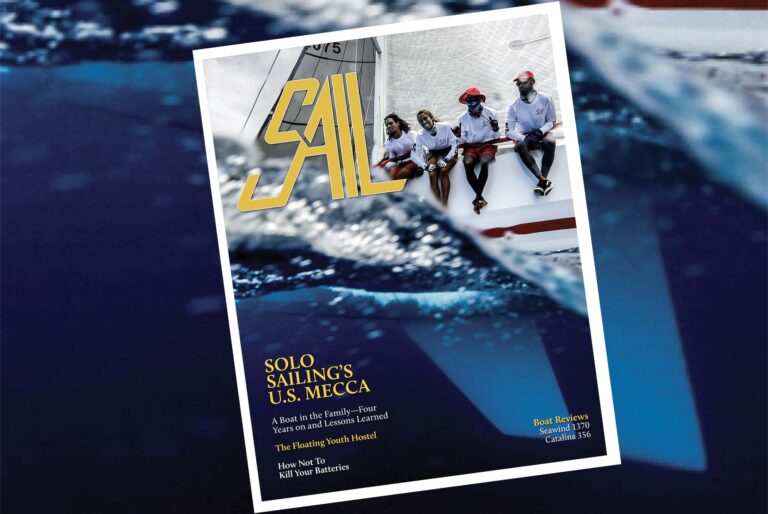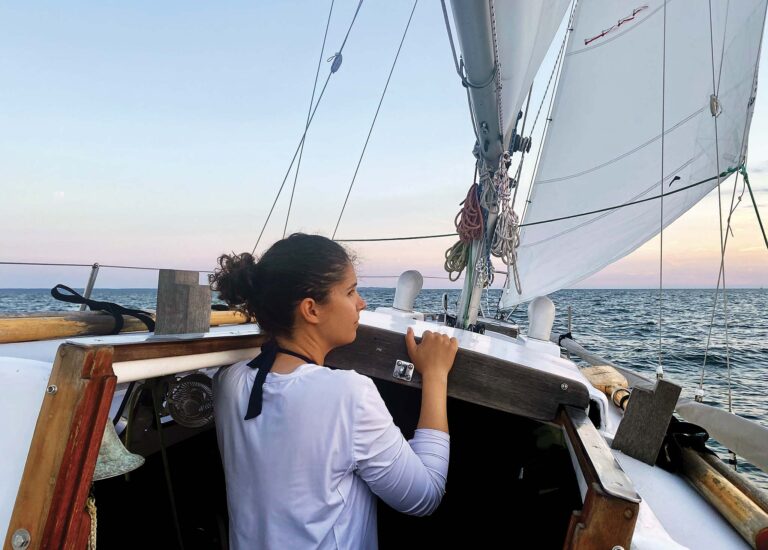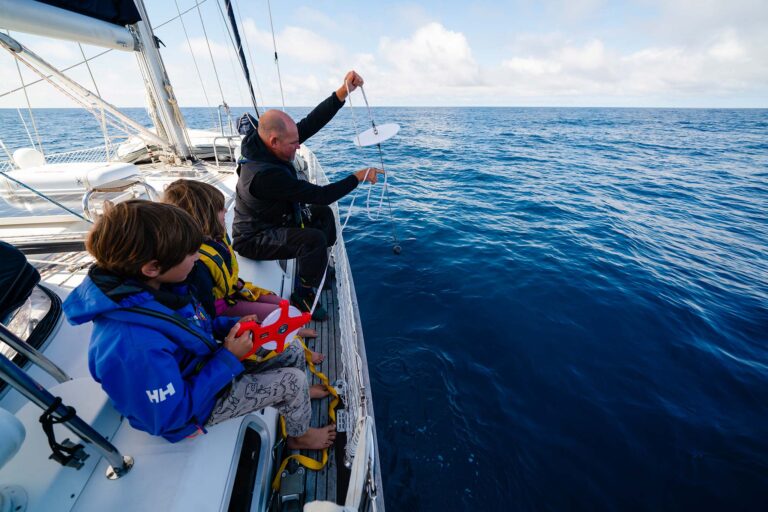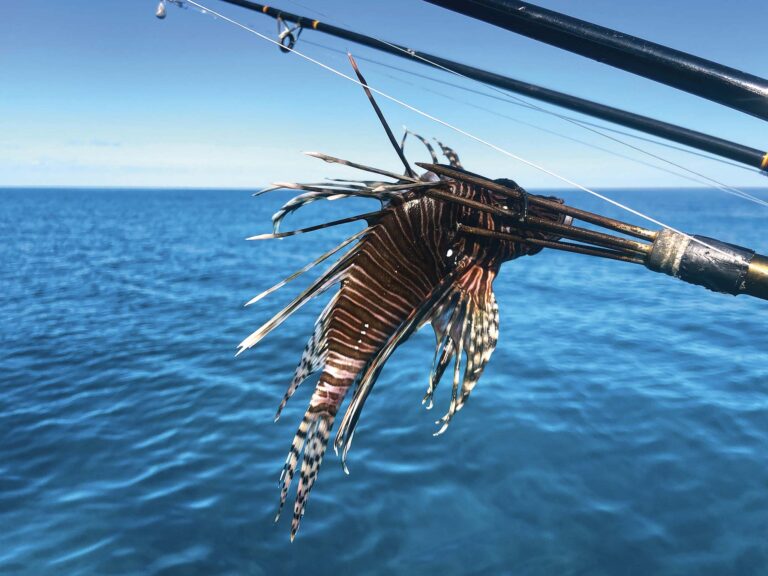The sea generates art like nothing else on the planet. Love runs it a close second and war features well too, but for an endless source of great reading, there’s nothing like sailing.
Prodigal antiquarian book-buying has long been a diversion enjoyed by my wife, Ros, who is a well-known figure prowling the dusty corners of coastal bookstores. Her online presence haunts their websites, while our own shelves groan under the weight of beautifully written works in which the west winds blow, the trades hum, grass skirts sway under moonlit palms and desperate men battle against ice and gale to save not only their ships, but their immortal souls as well.
The catalogue of sailing books keeps building as more and more of us take to the water, but looking through our library I’m bound to conclude that, with notable exceptions, my own favorites come from before World War II. These were the words that sent me to sea back in the late 1960s when a career as an attorney threatened to keep my feet dry for a lifetime. Alan Villiers started me off at the age of fourteen, but it was Bill Robinson’s Deep Water and Shoal that finished the job.
If you’re lucky enough to come across a copy, clasp it to your bosom and devour it from cover to cover. You won’t be disappointed. It is the very essence of adventure. Robinson bought a 32 foot Alden-designed sloop for a few hundred dollars, sailed away with less, yet circumnavigated with outstanding success. His book was set off by a foreword from Weston Martyr (of Southseaman fame) which concluded with the immortal phrase, “By Gum, go and do thou likewise!” In due course, that is more or less what I did. Many could say the same.
These pre-war books are invariably well crafted, often with that dry brand of humor which makes the current fashion for unloading one’s emotions onto anyone who will listen sound pretty silly. A motif of self-sufficiency runs through the stories like a golden thread. For the folk of that generation who chose to go deep-sea, the guarantee of salvation did not lie at the touch of an electronic button. They were obliged to fend for themselves and, if the ship sank, many would have little choice but to drown like gentlemen. Their lives were on the line.
Some writers have achieved legendary status without ever setting out to be authors. Everybody knows that Joshua Slocum was the first to circumnavigate single-handed. That he achieved this in an old boat he bought off the beach outside New Bedford and fitted out himself seems less remarkable when one realizes he was a master mariner with time on his hands for whom the call of the sea could not be denied. But how many have actually read Sailing Alone Around the World in its entirety? His story about repelling boarders in Tierra del Fuego by spreading tin tacks around his deck is embedded in the sailor’s lexicon, but who has studied his whimsical tale of the pilot of the Pinta who sailed with Columbus? The pilot’s shade clambered aboard Spray to sail her through a stormy night when Slocum was laid low after consuming what turned out to be hallucinogenic victuals in the Azores. Anyone who has voyaged the wastes of the central Atlantic, seen the crater of Pico hovering in the sky, and felt the spirits of the Portuguese who discovered so much with so little, will relate to this remarkable piece of writing.
While Slocum stands at the gate of yachting’s hall of fame, somewhere down in the basement sails an equally evocative writer who almost nobody knows about. This is because his book, The Boy, Me, and the Cat, was produced privately to the tune of only 500 copies. Thankfully, a visionary publisher resurrected it. It is the work of Henry Plummer, a New Englander with an eye problem who sailed a 23-foot catboat to Florida in the winter of 1914 with his teenage son and his cat, Scotty. These days, such a trip is so common and the waters so well marked that nobody would bother to write about it. If they did, few would give their work a second glance. Henry Plummer is from a different mold. The wry, self-effacing style of this veritable pioneer is pure Yankee and his comments on the life and times of the East Coast a hundred years ago are enlightening.
A week or two back I was tucked up snugly in bed around midnight with Henry when he piled up on the frozen mud in a deserted snow-bound creek somewhere in Carolina. His comments were so pithy that I burst out laughing and woke my wife. Had I been reading today’s newspaper I would have suffered a major earful. When I explained that it was only Captain Plummer up to his tricks again she turned over with a smile.
Although the classics must form the basis for appreciating what we have, it would be a mistake to ignore new work coming on-stream. Much of the writing in the internet age is unexceptional and the tales already told, yet, as always, it’s not what you have to say that counts, it’s the way you tell it. Some exquisite recent descriptions of coastal cruising give the lie to the fallacy that only stories of forty-foot seas, mutiny and tumbling spars are worthy of the connoisseur’s consideration.
I have just finished Southern Winds in which Sebastian Smith, a young wanderer of mid-Atlantic parentage, sails the Mediterranean with his French wife. The voyage has been made so many times that I almost passed the book up, but once immersed in its flowing prose and scholarly understanding of those waters, I knew I’d struck gold again. To read of a stormy passage down the coast of Italy in which the author’s anxieties, discomfort and, ultimately, hopes of redemption, are mixed with a lively rendering of the fate of the poet Shelley off the same shores makes for a read of huge satisfaction. And that is before you’ve met up with Odysseus, the crazy Greek fisherman and the god of the great north wind.
Truly, we sailors have much to be thankful for. Read on, shipmates, and keep writing too. So long as the sea is salt, there is every hope that the supply will never end.
Tom Cunliffe’s book on nautical literature, In the Wake of Heroes, will be published by Bloomsbury in 2015
Other Great Sailing Reads
The SAIL crew has its own reading list. Here are a few favorites
Charles J Doane
Sailing to the Reefs, Bernard Moitessier
This is the book that first made Bernard Moitessier famous in France, where it was originally published as Un Vagabond des Mers du Sud in 1960. Its success enabled him to build Joshua, the 40-foot ketch that he sailed on the voyages that made him famous internationally. It is in this book that we meet Moitessier the apprentice ocean sailor, a man who has discovered that the sea is his true home, but is still learning how to flourish in it. In his later books his voice is self-consciously that of a sailing evangelist; here his voice seems truer, more genuine and is ultimately more engaging.
Song of the Sirens, Ernest K. Gann
Ernest Gann was, among many other things, a professional pilot whose books about flying are still hailed as classics by the aerial literati. This autobiographical memoir documents his other great passion, for sailing and the sea, and tells of all the vessels that nurtured it in him, most particularly a 117-foot schooner-turned-brigantine, Albatros, that he owned and maintained for several years. This is a lively, entertaining compendium of sailorly anecdotes, all of them expertly related and organized.
Peter Nielsen
Desperate Voyage, John Caldwell
Left on the beach in Panama at the end of World War II, merchant mariner John Caldwell is desperate to get to Sydney to rejoin his Australian bride. One problem—it is impossible to get a ride across the Pacific. What’s an enterprising young seaman to do, except buy a sailboat and head west? Can’t sail? Bah—how difficult can it be? And thus begins an odyssey that is equal parts adventure and ordeal, as the ill-prepared Caldwell, accompanied by two cats and a stowaway rat, faces storm, starvation and a titanic battle with a shark on a Pacific that is anything but. A terrific winter read.
The Shipkiller, Justin Scott
Back in the early 80s, you could find a copy of The Shipkiller on just about every sailor’s bookshelf. It’s arguably the best-known example of that rare genre, the sailing-literate thriller—Bernard Cornwell and Sam Llewellyn are the only writers who’ve matched Scott’s eye for sailing detail and knack for cliffhanger chapter endings. The plot is simple—tanker runs down sailboat, sailor seeks revenge on tanker—but it’s the non-stop action in the hero’s long voyage from the chilly waters of the North Atlantic to the explosive climax in the Persian Gulf that keeps you turning the pages.
Adam Cort
Youth, Joseph Conrad
Largely autobiographical, Joseph Conrad’s Youth tells the story of a young mate on his first voyage to the East aboard the old run-down square-rigger Judea. Storms, leaks, collisions, a load of coal that catches fire partway to its destination: you name it, if it can happen to a ship at sea, it happens to the Judea. But in the throes of the narrator’s infatuation with all things maritime, none of it matters. “Tell me,” he relates years later as a grizzled veteran, “Wasn’t that the best time, that time when we were young at sea; young and had nothing, on the sea that gives nothing, except hard knocks—and sometimes a chance to feel your strength?” Amen to that.
Godforsaken Sea, Derek Lundy
Although not as well known John Rousmaniere’s classic Fastnet Force 10, Derek Lundy’s Godforsaken Sea is another one of those books that really let’s the reader feel what it must be like to go through a killer storm at sea. For his subject, Lundy chooses the 1996-97 Vendée Globe, a star-crossed event in which of the 16 solo sailors who entered, only six finished, three were wrecked and one, Gerry Roufs, perished in the Southern Ocean. Re-visiting the Vendée Globe in its formative years makes you realize how far both the event and shorthanded racing in general have come in the last 15 or so years—anyone care to go to sea aboard an Open 60 that is as stable upside down as it is right side up? One thing that hasn’t changed is the courage of the sailors taking part. Read this book and you’ll never see ocean racing the same again.

